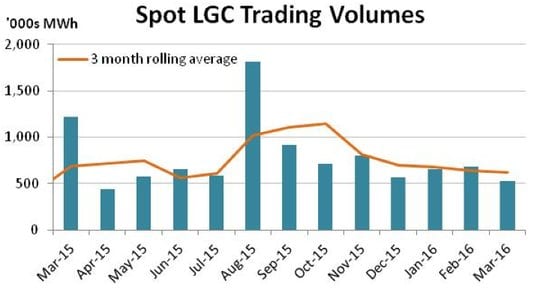In marked contrast to most of 2015, the first three months of 2016 in the Large-scale Generation Certificate (LGC) market brought softening prices and a reduction in liquidity levels. Yet the year has also yielded the first long term power purchase between a project developer and a major liable entity.
Large-scale Generation Certificate (LGCs)

2015 was an amazing year in the LGC market. The spot price soared from the low $30s as it became clear that firstly, the Abbott Government didn’t have the numbers to seriously enfeeble or repeal the Renewable Energy Target and, secondly, that a compromise between the major parties to reduce the target would occur.
There were very few, however, who believed the spot would reach the high $70s by year’s end, although that is precisely what happened with the market peaking in early December at $77.00. From there the market softened to end the year at $72.80.
In the New Year the market gathered some momentum in the second half of January pushing through the $80.00 mark on its way to a high of $83.75 by month end. With the theoretical market cap (the tax effective penalty) sitting just short of $93 however, it was simply implausible that the spot price would continue moving upward forever and, with the expected LGC shortfall still at least 2 compliance periods away, a change in dynamic was hardly surprising.
With the final compliance period for 2015 (14th February) approaching however, the market began a downward run that would last over two months and result in the spot softening over 10% off its high.

Where buyers had been so strong across January, they became increasingly hard to come by across February with the spot closing that month at $80.50. Across March this trend became more pronounced and the downward trend more consistent. The spot ultimately closed the month at $75.00.
Some pundits put the decline down to the passing of the compliance period. Others believe it was more a reflection of the spot having soared too high, to quickly. In reality it was likely a result of both these factors alongside a range of other dynamics. In early April the spot price has since recovered to surpass the $78.00 once again.

Over-the-counter trade activity was relatively consistent across the first three months of the year with the 3 month rolling average sitting above 600k during that time.
With the spot price so high, the forward market has been jumpy. Calendar 16 and Calendar 17 have remained in contango (i.e. an escalation above spot). However the curve was flatter in the Cal 18 vintage across most of the year, reflecting the greater level of uncertainty that exists in terms of supply/demand potential and for regulatory change. The recovery in spot prices in early April has coincided with a return to contango in Cal 18.
March did bring some movement on the long term contract side of things with a 15 year deal announced for a 56MW solar PV project in New South Wales. Whilst the deal did not represent a new project commitment, its 15 year duration was at least a positive sign in what has otherwise been a heavily stunted space.
The sheer size of the project commitment effort is enormous and appears increasingly unrealistic as each month goes by. Without a staggering run of commitments in the coming months or some change to the target’s profile, the market appears set to continue toward penalty for the Cal 17 compliance year.
Small-scale Technology Certificates (STCs)

For the nation’s small-scale renewable market, the early part of 2016 was much the same as the latter part of 2015, with the Clearing House in deficit resulting in stable prices and minimal market activity. The release of the 2016 Small-scale Technology Percentage (STP), whilst likely to require a considerably smaller number of STCs to be surrendered across 2016, was not low enough to cause major concern about a change in the status quo.
The spot STC market spent most of the early part of 2016 trading sporadically between $39.85 and $40.00, with the Clearing House remaining in deficit across most of Q1. Late in 2015 an increase in the number of forward and options transactions for settlements across 2016 reflected some concern amongst participants that the target to be set for 2016 may ultimately be released at a level low enough to cause an oversupply and hence see prices depart from the $39.85-$40.00. At 9.68%, expected to be equivalent to 16.95m STCs surrendered across 2016, the release of the 2016 STP failed to stoke fears of an oversupply of STCs.
With no surplus to roll forward from previous years, short of a major supply side response it appears unlikely that a material surplus of STCs above the circa 326k per week required by the target will eventuate.
Recent activity in the spot STC market has taken place at $39.90.
Marco Stella is Senior Broker, Environmental Markets at TFS Green Australia. The TFS Green Australia team provides project and transactional environmental market brokerage and data services across all domestic and international renewable energy, energy efficiency and carbon markets.










